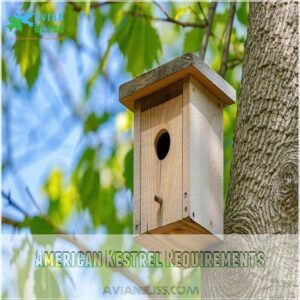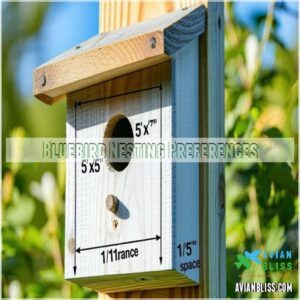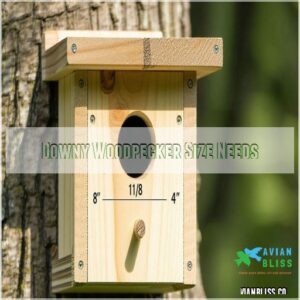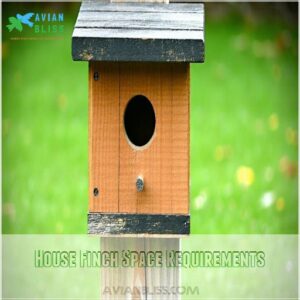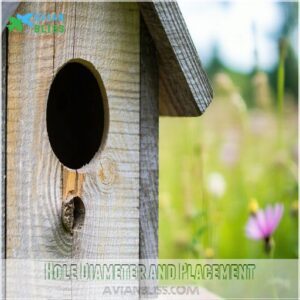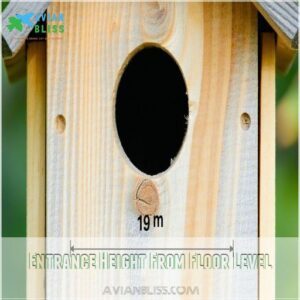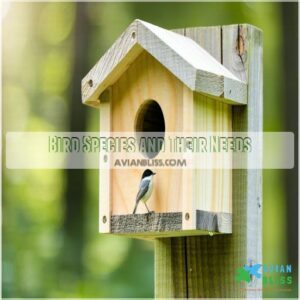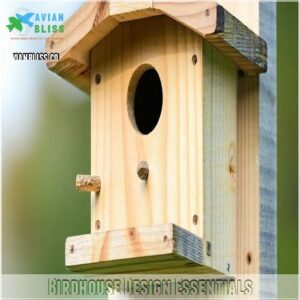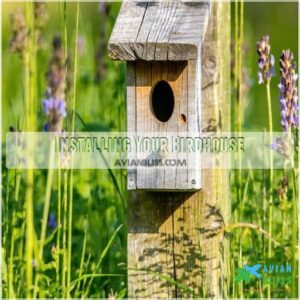This site is supported by our readers. We may earn a commission, at no cost to you, if you purchase through links.
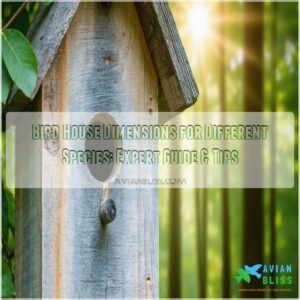
You’ll need to match the dimensions to your feathered friends’ needs.
For instance, bluebirds prefer snug boxes around 5×5 inches inside, while barn owls seek much larger spaces, about 12×18 inches.
Don’t forget the entrance hole size: chickadees like theirs just 1 1/8 inches wide, keeping out unwanted guests like starlings.
Whether crafting cottages for tiny titmice or villas for wood ducks, the right bird house dimensions for different species help make sure happy residents.
Stay tuned; there’s more to discover in perfecting your avian architecture!
Table Of Contents
- Key Takeaways
- Birdhouse Size Considerations
- Ideal Birdhouse Dimensions
- Protecting The Entrance Hole
- Bird Species and Their Needs
- Birdhouse Design Essentials
- Specific Species Birdhouse Dimensions
- Installing Your Birdhouse
- Frequently Asked Questions (FAQs)
- What size holes for different bird houses?
- What are good dimensions for a bird house?
- Are there different bird houses for different birds?
- What size birdhouse for chickadees?
- What colors attract birds to a birdhouse?
- How high should a birdhouse be placed?
- Do birdhouses need ventilation openings?
- Is painting a birdhouse recommended?
- Can predators reach birdhouses easily?
- Conclusion
Key Takeaways
- You’ll need to match birdhouse dimensions to the specific species you want to attract; different birds have drastically different size requirements.
- Entrance hole size is crucial for keeping out predators while allowing the target species easy access. Smaller holes deter larger predators.
- Consider the bird’s nesting habits and brood size when determining the necessary interior space. You don’t want it too cramped or too spacious.
- Proper placement and orientation of the birdhouse, including height and sun exposure, are key to maximizing its appeal and providing a safe haven for the birds.
Birdhouse Size Considerations
When building a birdhouse, you’ll want to make sure it’s not just roomy enough for adult birds and their growing brood, but also snug enough to keep out pesky predators.
Choosing the right size gives birds a comfy and secure place to raise their young, so you won’t end up with tenants complaining about cramped quarters or unwanted guests.
Space for Adult Birds
Building a birdhouse? Designing for a comfortable fit is key! Adult birds need enough space to comfortably maneuver, preventing feather damage. Consider these points:
- Wingspan: Make sure there’s ample space for wing expansion.
- Birdhouse Entry: A properly sized entry hole is important.
- Nesting Space: Sufficient room for turning and resting.
- Comfortable Fit: Avoid overcrowding to prevent stress.
Getting the birdhouse dimensions right is essential for happy birds!
Typical Brood Size
A birdhouse isn’t just a cozy crib for adults; it has to handle a brood, too.
Depending on the bird species, average clutch size can range from a tiny trio to seven squawking nestlings.
For example, bluebirds, which often require specific bluebird house dimensions, typically have a brood size of two to five.
Brood size impact on space is big.
Nestling development and nest success often hinge on having spacious, well-designed nesting boxes suited to specific needs.
Size of Fledglings
As fledglings grow, understanding their development is key.
You’ve got to keep in mind their growth rate and how this influences the birdhouse dimensions.
Fledglings need enough space to flutter as they practice independence and survival skills.
Imagine their tiny wings stretching as they learn to fly.
Make sure your birdhouse supports fledgling care without cramping their style.
Predator Safety
Imagine a raccoon eyeing a birdhouse like a fast-food joint.
For predator safety, keep entrance holes small and high to deter unwelcome guests.
You can also consider investing in a predator proof birdhouse designed with security features to protect the birds.
Predator deterrent methods include using metal liners around entrance holes to prevent gnawing.
A proper birdhouse placement and secure dimensions can protect cavity-nesting birds, keeping them safe and sound.
Prioritize entrance hole security and strong materials.
Ideal Birdhouse Dimensions
You might think birdhouses are one-size-fits-all, but each species actually prefers a specific blueprint, much like how some folks swear by pineapple on pizza while others don’t!
From the roomy digs needed by the American Kestrel to the compact nests favored by bluebirds, understanding these dimensions can help make your feathered tenants feel perfectly at home.
American Kestrel Requirements
For the American Kestrel’s abode, think of a cozy nesting box with an internal floor space of 8 by 8 inches, and a height between 12 to 15 inches.
Perched like a sentry, this home should have an entrance hole placed 9 to 12 inches from the floor.
This setup helps during the Kestrel breeding season in ensuring safety and comfort.
Bluebird Nesting Preferences
Switching from American Kestrels to bluebird buddies, let’s chat nest boxes.
Bluebirds crave a cozy spot, 5"x5" floor with a 1 ½" entrance, perched 5 feet up.
Use untreated wood, like pine, to keep things natural—just avoid flashy colors.
Bluebird breeding season’s fun, so keep their nest box clean and watchful, practicing regular Bluebird nest box monitoring.
Downy Woodpecker Size Needs
Bluebirds prefer snug spaces; Downy Woodpeckers, however, need a bit more room.
Their birdhouse should have a floor around 4 by 4 inches, and stand 8-10 inches tall.
The entrance hole? About 1 1/8 inches above the floor. Got it?
These little guys are tiny dynamos, busy flitting about, consuming insects, and raising their young.
Providing a proper home helps in downy woodpecker conservation efforts.
Remember, a well-built birdhouse is a key to successful downy woodpecker nesting habits.
House Finch Space Requirements
Creating a house for a house finch is like crafting a cozy studio apartment.
Aim for a nest box size of 6 inches on all sides—just right for their modest family.
You can find various house finch birdhouse designs online, such as on the website about House Finch Birdhouse, to inspire your DIY project.
These birds enjoy a mess, so let their DIY flair shine with twigs and feathers.
Remember, the entrance should be about 1.5 inches wide, offering safety and comfort.
Protecting The Entrance Hole
When you’re setting up a birdhouse, getting the entrance hole right is like picking the perfect front door—just the right size keeps unwanted guests out while letting your feathered friends in.
A snug fit helps birds feel safe, so check that the hole diameter suits the species, and make sure it’s at the correct height above the floor to keep predators at bay.
Hole Diameter and Placement
When sizing birdhouses, you’re like Goldilocks finding the perfect fit.
The entrance hole diameter and placement are key to attracting diverse bird species.
Consider these when planning:
- Smaller holes deter predators
- Larger diameters welcome bigger birds
- Low placement avoids rain
- Proper size keeps birds safe
- Correct dimensions guarantee happy nesters
Entrance Height From Floor Level
Ever wonder how high the entrance should be for birdhouse safety?
Height truly matters.
Too low, and predators might crash the bird party; too high, and birds struggle while nesting.
A golden rule? Aim for the right height based on species preferences.
Think of it as customizing their cozy nest, ensuring nesting comfort and keeping predators at bay.
Safe Entrance Hole Size
While entrance height matters, getting the hole diameter right is just as important for predator protection.
Think of it like Goldilocks: not too big, not too small, just right.
Each species has its own ‘perfect fit,’ so check a birdhouse hole size chart.
This guarantees bird safety, letting them nestle in with peace of mind and ensuring proper birdhouse dimensions.
Bird Species and Their Needs
Understanding the specific needs of different bird species helps you provide the perfect home for their brood, making you the ideal landlord for your avian friends.
From small chickadees to stately purple martins, each species requires unique dimensions and features to feel cozy and safe, so grab your measuring tape and get ready to impress some feathered tenants!
American Robin Nesting Shelf
Building a nesting shelf for American Robins? That’s awesome! Robins prefer open spaces, so forget the enclosed birdhouse.
Here’s what you need to know for successful Robin breeding habits:
- A 7" x 8" shelf.
- An 8" height.
- Mounting 6-15′ above the ground.
- A sturdy, weatherproof design.
This simple Nesting Shelf Design helps create Bird Friendly Yards, perfect for Backyard Birding Tips and Urban Wildlife Conservation.
Happy birding!
Northern Flicker Space Requirements
For Northern Flickers, it’s like finding the perfect tree cavity that mirrors a cozy, rustic cabin in the woods.
They prefer birdhouses with a 7×7 inch floor and a height of 15-18 inches.
Remember, the entrance hole should be 2.5 inches wide.
This mimicry of natural nesting sites keeps them safe and snug, offering peace of mind even in urban jungles, which provides a sense of peace of mind.
Chickadee Nesting Preferences
Chickadees, those little songbirds, love cozy nesting spaces.
They prefer a nesting box depth of 8-10 inches with an entrance of 1 1/8 inches—just enough room for them to sneak in, avoiding bigger, pushy neighbors.
For nesting box orientation, pick a spot away from wind, ensuring small bird safety.
It’s like rolling out a fluffy nest welcome mat!
Purple Martin Colony Size
Spotting Purple Martins as they glide into their birdhouses is a treat.
These sociable flyers love to hang out in colonies. Imagine the chatter at a family reunion!
- Colony Nesting Dynamics: Key for community life
- Martin Roosting Behavior: Cosy and social
- Group Migration Patterns: Marvel of nature
- Social Flocking Habits: Adds charm
- Nesting Site Selection: Carefully chosen spots
Birdhouse Design Essentials
When building a birdhouse, you’ll need to guarantee good ventilation and drainage to keep your feathered tenants comfortable.
While choosing the right type of wood and thickness is just as important.
Avoid paints and bright colors that might deter birds.
Make sure the design allows easy cleaning, or you might find your fancy new house remains as empty as that chore list you’ve been avoiding.
Ventilation and Drainage
Birdhouses aren’t just about the right dimensions; it’s about breathing room too.
Guarantee ventilation with gaps under the roof. A good roof overhang shields from rain, while small drainage holes prevent moisture buildup.
Imagine inviting guests over without windows. Birds feel the same! Proper birdhouse orientation helps airflow, keeping residents comfy and safe like a cozy cabin in the woods.
Wood Type and Thickness
Choosing the right wood for birdhouses is like selecting a cozy home.
Cedar’s durability and natural aroma make it ideal for birdhouse materials, resisting rot like a champ.
Opt for sustainable lumber to give birds a safe spot—no plywood alternatives here.
Stick to 3/4" thickness for birdhouse dimensions to suit different species, ensuring critters are snug and secure.
Avoiding Paint and Bright Colors
Sure, you’ve got your wood type sorted, but let’s chat color!
Bright colors might catch your eye, but birds prefer a subtle look.
Think earth tones—nature’s way of saying, "Welcome!"
Camouflage keeps predators guessing while also helping birds feel at home.
So, go dull, like a whisper in the wind, for perfect birdhouse vibes!
Easy Cleaning Design
Imagine giving birds a tidy home by designing with an easy cleaning design in mind.
Equip your birdhouse with a removable floor or a clever cleaning hatch for effortless maintenance.
This simplifies sanitation and helps your feathered friends thrive.
An accessible birdhouse keeps you on top of birdhouse dimensions, entrance hole diameter, and overall maintenance.
Specific Species Birdhouse Dimensions
When you’re building birdhouses, it’s important to match the dimensions to your feathered tenants—Barn Owls and Wood Ducks need spacious abodes, while Tits and Sparrows prefer cozier spaces.
By tailoring house size and features to species-specific needs, you’ll create a welcoming haven, ensuring each bird family finds a comfy and practical home.
Barn Owl and Wood Duck Requirements
Barn owl and wood duck nesting needs can make you feel like a real woodland architect. To get it right, remember:
- Cavity Size: Barn owls need a spacious 12"x12"x16" interior, while wood ducks thrive in 10"x18"x24".
- Entrance: Make sure there’s a hole of 6" and 4" respectively.
- Predator Protection: Install baffles to keep these feathered friends safe!
Tit and Sparrow Nesting Preferences
Let’s explore the world of tits and sparrows!
These tiny birds have specific nesting preferences you should know about.
Their nest boxes need to be snug but not cramped.
Check out these ideal dimensions:
| Species | Floor Size (inches) | Height (inches) | Entrance Hole Size (inches) |
|---|---|---|---|
| Great Tit | 4 x 4 | 8-10 | 1 1/8 |
| House Sparrow | 5 x 5 | 6-8 | 1 1/4 |
| Tree Sparrow | 4 x 4 | 6-8 | 1 1/8 |
Remember, proper Tit and Sparrow Nest Box Design is key for a successful breeding season!
Bluebird and Swallow Space Needs
When thinking about birdhouse dimensions, bluebird nest box size needs to be cozy yet spacious.
Bluebirds thrive in birdhouses with a floor size of 5×5 inches and an entrance hole size of 1.5 inches.
As for swallows, make sure their house has a bit more room with a similar hole.
It’s all about fitting their needs for safe, snug homes.
Robin and Finch Nesting Shelf
Think about robin and finch homes like cozy little apartments with open views.
When planning these nesting shelves, consider these essentials and make sure you’re using durable birdhouse materials that can withstand the elements.
- Nesting Materials: Line the shelf with soft moss or dried grass—birds love a comfortable bed.
- Ideal Dimensions: Robins enjoy a 7"x8" space; keep it simple and tidy.
- Predator Protection: Place high or use secure coverings.
Installing Your Birdhouse
When you’re ready to install your birdhouse, pay attention to the height and location to make sure birds find it welcoming and safe.
Consider the direction it’s facing too; even birds might prefer a room with a view that’s not sunny all day or too drafty.
Mounting Height and Location
Positioning birdhouses is a bit like picking the primo tree for your treehouse dreams.
Consider safety and comfort—mount them 5 to 10 feet high, depending on bird type, ensuring predator safety while allowing easy access.
You can find more information on best birdhouse mounting height through various online resources, such as a birdhouse mounting height guide.
Check this handy guide:
| Bird Type | Height Range | Habitat | Sunlight |
|---|---|---|---|
| Bluebird | 5-7 | Open fields | Morning sun |
| Chickadee | 6-12 | Woodland | Partial shade |
| Robin | 6-15 | Gardens | Full sun |
| Woodpecker | 10-15 | Trees | Filtered sun |
Direction and Orientation
With your birdhouse, aim for an ideal placement. Face it in the direction of the rising sun to dry morning dew, but avoid direct winds by sheltering it with a tree. Use tree shade to keep things cool in summer, avoiding scorching heat.
- Facing the Sun helps warmth.
- Wind Protection with natural barriers.
- Use Tree Shade for coolness.
- Ensure Proper Birdhouse Dimensions for comfort.
Installing Multiple Birdhouses
Visualizing your backyard like a bustling neighborhood helps guide birdhouse placement.
Spacing birdhouses appropriately prevents species competition, allowing each bird family to settle in peacefully.
Remember, variety is the spice of bird life! Mixing different birdhouse sizes and types caters to various species, offering a warm welcome.
Aim for natural settings to boost the likelihood of feathered tenants.
Maintenance and Upkeep
After setting up your birdhouses, remember regular maintenance keeps them in tip-top shape.
A spring cleaning schedule removes old nests and debris, and it’s also essential to follow proper bird house cleaning tips, such as clean birdhouse techniques, to guarantee the health and safety of the birds.
Check for damage, making sure structural integrity and birdhouse safety.
Winterizing birdhouses protects them from the elements.
Pest control prevents infestations.
Understanding material durability helps you plan for repairs, keeping those feathered friends happy and safe.
Frequently Asked Questions (FAQs)
What size holes for different bird houses?
For birdhouse entrance holes, use 1 1/2 inches for bluebirds, 2 1/2 inches for northern flickers, and 1 1/8 inches for chickadees. Get the right size so they feel secure and cozy.
What are good dimensions for a bird house?
Think of a birdhouse like a cozy studio apartment for birds.
Size matters for each species!
For bluebirds, use a 5"x5" floor with an 8"-12" height.
Chickadees need 4"x4" floors, 8"-10" high.
Are there different bird houses for different birds?
Yes, different birds need specific houses, kind of like their version of a custom-made home.
Bluebirds, owls, and woodpeckers each have unique size and entrance preferences.
This ensures they’re safe, comfy, and ready to welcome feathered guests.
What size birdhouse for chickadees?
Did you know chickadees are tiny powerhouses? Build them a snug house: 4×4 inches floor, 8-10 inches tall, with a 1 1/8-inch entrance hole, about 6-8 inches from the floor.
What colors attract birds to a birdhouse?
To attract birds to a birdhouse, use earth tones like browns, greens, and grays.
These mimic natural environments, helping birds feel safe.
Avoid bright hues which can repel them, making them skittish of vibrant colors.
How high should a birdhouse be placed?
Think of a birdhouse like the penthouse of the tree world. Place it 5 to 15 feet high. Higher for larger birds like owls; lower spots work well for bluebirds and chickadees.
Do birdhouses need ventilation openings?
Absolutely, birdhouses need ventilation openings.
These allow air to circulate, preventing overheating inside.
Make sure you’ve got small holes near the top.
Birds appreciate the airflow; otherwise, their cozy home could turn into a sauna!
Is painting a birdhouse recommended?
They say, "The devil’s in the details."
Avoid painting birdhouses; paint can trap heat and deter birds.
Stick to natural materials like cedar or redwood for a welcoming home that breathes, ensuring birds feel right at home.
Can predators reach birdhouses easily?
Predators can reach birdhouses if they’re not properly secured or designed.
Keeping entrance holes small and placing them high enough deters intruders.
Make sure birdhouses are sturdy and well-constructed to protect your feathered tenants from uninvited guests.
Conclusion
Surprisingly, tailoring birdhouses isn’t just about snagging the right wood—it’s about meeting specific needs.
You’ve explored how to cater to various species with precise bird house dimensions for different species, from cozy bluebirds to expansive barn owls.
Paying attention to entrance holes, height placement, and predator protection makes for happier avian tenants.
Whether you’re building for chickadees, finches, or kestrels, your efforts create safe, welcoming homes.
Remember, every birdhouse matters in your local ecosystem!


